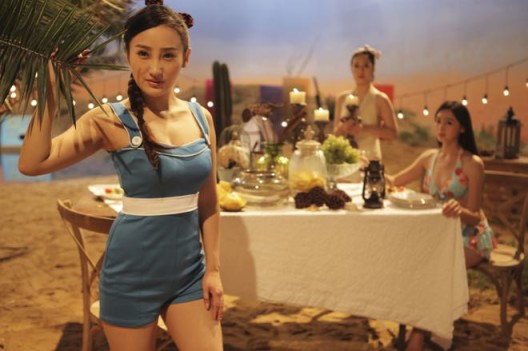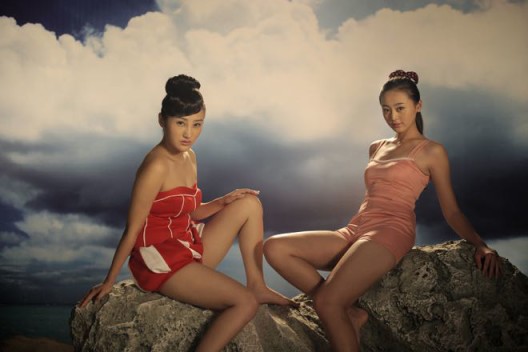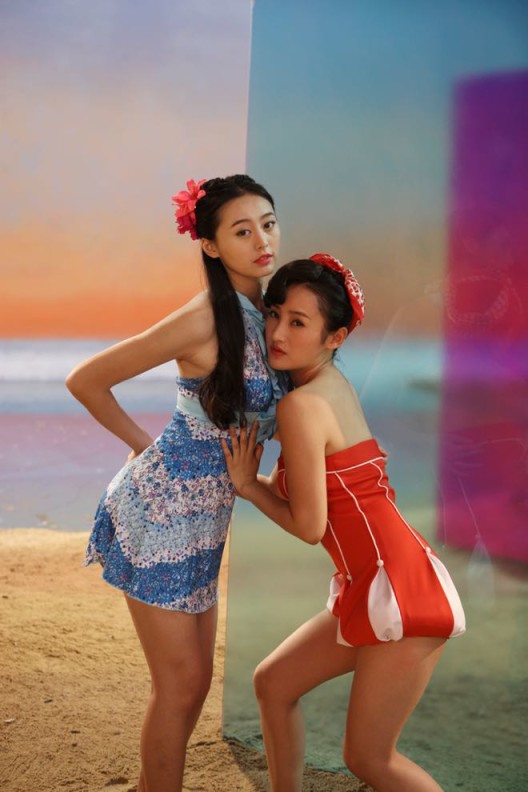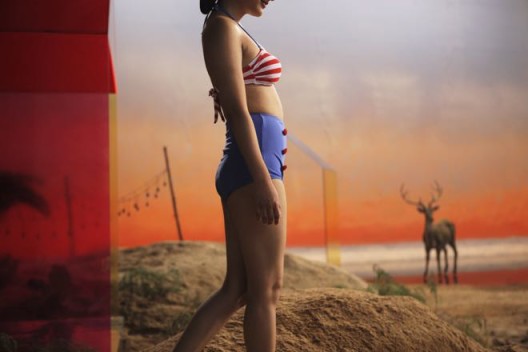Yang Fudong “The Coloured Sky: New Women II”
Marian Goodman Gallery (79 Rue du Temple, Paris) April 18–May 30, 2015
China’s equivalent of “The Emperor’s New Clothes” is the idiom “to point at a deer and call it a horse” (zhĭ lù wéi mă 指鹿為馬). Dating from the short-lived Qin Dynasty (221–206 B.C.), the fable recounts how the ambitious Prime Minister, Zhao Gao (趙高), tested the loyalty of court officials with a malevolently absurd game. While on a trip with the Emperor, Zhao rode a deer. The Emperor asked Zhao, “Why?” But Zhao maintained he was riding a horse and asked the officials their opinions. Half agreed Zhao was riding a “horse”—they were loyal (or, at least, sufficiently afraid). The Emperor began to doubt himself. A deer and a horse are present in Yang Fudong’s 2011 film about historical ambiguity, “Yejiang/The Nightman Cometh”, and now again in a new film installation.
Commissioned by the Australian Centre for the Moving Image (ACMI) and the Auckland Art Gallery Toi o Tamaki, Yang Fudong’s, “The Coloured Sky: New Women II” is showing in Europe for the first time at Marian Goodman Gallery in Paris. Five portrait and landscape-format screens are arranged in a partial circle in a darkened room. Three women—who may be versions of the same woman—are shown playing at the beach in chic 1940s swimsuits. They run on the sand and perch on seaside rocks. Sometimes they pose seductively, sometimes joking, sometimes sad, at others stern. It is a beguiling, child-like sequel to “New Women” (it is unnumbered, so to avoid confusion, in this article I designate it “New Women I”), which premiered at ShanghART in Shanghai in 2013. “New Women I” was a sensual, black and white display of nude women, from young adult to middle age, in high makeup and bejeweled with necklaces. The images reference iconic Surrealist work, most notably “Black and White” (1926) by Man Ray (1890-1976) but also more generally the work of pioneer photographer Lang Jingshan (郎静山), famous among other things for taking “Meditation” (1928), the earliest surviving Chinese nude art photograph (now in the collection of NAMOC), followed by the publication of “Album of Nude Photographs” in 1930.

The title “New Woman” derives from a 1935 Shanghai film about a music teacher who commits suicide after her career is ruined by a succession of men—a school board member, her publisher and a journalist—each of whom lusts after her. The film was based on the life of actress Ai Xia; the film’s star, Ruan Lingyu, similarly harassed (by the media), also killed herself. (It could be said that it is China’s counterpart to Josef von Sternberg’s classic “Der Blaue Engel” (1930), with Marlene Dietrich and Emil Jannings, but also alludes to recent scandals involving nude images of Hollywood actresses stolen from their private online accounts.) The five-screen installation presents at once a voyeur’s dream and nightmare—idealized woman, unreachable, untouchable and unknowable. She is self-conscious but not ashamed—beautiful, certainly, but also self-possessed, without need of men. They are Amazonian statues and goddesses. It recalls obliquely the inferred decadence of Yang’s photographic series, “Ms. Huang at M. Last Night” (2006), but here the decadence lies not on-screen but in the projection of the fascinated, not necessarily male, viewer. The sequel does not involve the same poisoned invitation to scopophilia. The vision of “New Women II” is not a projection of desire but an unseen girl’s dream about growing up—the projection is self-centered.
Transparent colored screens stand amidst the beach scenes. Sometimes elements shift, such as a tent on the beach later switching apparently to a hut composed of the same colored screens. Quoting Botticelli’s “Birth of Venus”, the film features at different times a large seashell which is handled by the individual women. There is a rich banquet—sometimes appearing fresh, sometimes decomposing, corrupted by flies and snails—quoting 18th century Flemish still lifes (nature morte). Sometimes, a yellow snake appears among the food. At night, one woman is seen handling the gorgeous glistening serpent, this time quoting Adam and Eve except there is no Adam. 2015 is the Year of the Snake, which for those born under that sign is associated with characteristics such as wisdom, silence, jealousy and suspicion. It is a sign of good fortune and risk. Whether it is relevant to the film installation is left obscure. Two other animals play important roles—a stuffed deer and a real horse. The deer stands in the shallows of the water. The horse, when it appears, ignores the fake dear, lapping instead at the real water. But remember: both animals are projections. This is a film, one about perception and doubt.
It recalls Yang’s earlier film, “Liu Lan” from 2003, which concerns a young woman’s trepidation about her future. Of course, this is a metaphor: “Visualizing the protagonist’s desires and her anxiousness about entering adulthood, the film can be interpreted as a possible presentation of the complex encounter between modernity and tradition.” (1) “The Coloured Sky” shows the perspective of a young girl, her hopes and expectations about her future at a time when adult roles are simply performances to be aped, not feared. At a certain point, though, the installation takes over. The five screens presenting sun, sea, beach, games and food lull us into a false sense of security. A noise disturbs you—turn around. Two women stare angrily at us. Apparently some anxieties remain. Are we blocking their view? Have we not paying (them) enough attention? … Can they really see us? The scene dissolves, as do the players’ emotions, rapidly segueing from anger to laughter to fear to sorrow. Their mercurial temperaments are as disturbing as their disdain.


Seven Intellectuals in a Bamboo Forest
Yang Fudong was born in 1971 in Beijing. Following high school he went to the China Academy of Art in Hangzhou, second only in official rankings to the Central Academy of Fine Art (CAFA) in Beijing. Yang chose Hangzhou because it had a reputation for being less conservative than its counterpart in the capital. After graduating in painting in 1995 (2), he briefly returned to Beijing, where he took some photography classes at CAFA before financial pressure led him to move back south—this time to Shanghai—where he learned to use a computer; this in turn led to him working in video game production, making his own digital films in his spare time. Eventually though, he was fired. “My boss liked my work, but I took too much leave. He gave me three months’ compensation pay and said, ‘Now you can work on your art full time.”’ (3) Yang has been a full time artist ever since.
Yang’s official film career is often framed by tropes established early in his career in “An Estranged Paradise” (1997-2002), his first film, and “Seven Intellectuals in a Bamboo Forest” (2003-2007), a sequence of five black and white 35 mm films. The former relates the confusion of two young lovers in Hangzhou (the title refers to a popular nickname for the city), concerned about their future—particularly the man. “Seven Intellectuals”, set in another picturesque and culturally significant region—the Yellow Mountain—is a retelling of the story of Wei and Jin dynasty intellectuals who retreated from society to lead an aesthetic lifestyle engaging with nature.
In fact, Yang Fudong is a prolific filmmaker (see the incomplete filmography at the end of this article). Key works also include the whimsical “City Light” (2000) (after Charlie Chaplin’s 1931 romantic comedy and Dostoyevsky’s 1846 novel “The Double”), “Backyard—Hey, Sun is Rising!” (2001—Two men acting anachronistically in the modern world) and “Tonight Moon” (2000) (men playing like children or clowns in a garden) and the cinéma vérité-style of “East of Que Village” (2007—wild dogs on the outskirts of a parched village) and “Blue Kylin” (2008—marble carvers in a quarry). Either directly or by inference, these films balance perceptions of youth/maturity, hope/reality and freedom/responsibility.
In many respects, Yang Fudong’s films are chapters in the same story, albeit a non-linear one. Usually the story has no beginning and no end, no crisis, no denouement, no resolution. It is an existential present—confusion is of the moment. In contrasting ways, this can be seen in the unceasing fighting of suited criminals in “Dawn Mist, Separation Faith” (2009), the multiple-perspectives of diverse extras/subjects in “The Fifth Night”, and the interactions of the anachronistic characters on the battlefield of “Yejiang/The Nightman Cometh” (2011). To date the most important survey of the artist’s work was “Yang Fudong. Estranged Paradise. Works 1993-2013” in 2013 at the Zurich Kunsthalle and Berkeley Art Museum, curated by Philippe Pirotte and Beatrix Ruf. During the conference, the artist talked of how he imagined what was going on beyond the frame of a painting, what stories there were and what the characters would do. It has been noted that Yang’s films reflect notions of traditional Chinese painting in which multiple stories are recounted simultaneously. “Not only do paintings have spatiality, they also have temporality, and it is the resonance of this space-time relation that produces in the viewer an inner experience of a particular work.” (4). Or as Li Zhenhua has noted of “The Fifth Night”—“Seven screens formed seven scrolls.” (5)
This is not a stylistic game. Each film is also personal, a reckoning of how people in China at this particular moment of massive social and economic, even political, transformation can reconcile their history and future, success and responsibility. (6) Status is represented in many ways, whether in an aging general being honored at a dinner in the “General’s Smile” (2009), or privileged members of the young bourgeoisie drinking cocktails at a chic bar in “Ms. Huang at M. Last Night”. Yet as Hasegawa notes, “A feature of Yang’s work is the lack of hierarchy among its characters. The relationships that unfold are completely horizontal in nature” (7). The unfolding individual perspectives are equally powerless, flippant, naïve or confused. Sometimes privileged characters are shown enjoying themselves (in photography, “Ms. Huang at M Last Night” and “International Hotel”, and in film “General’s Smile” (2009), and now “The Coloured Sky”). In other works, characters are left confused—shocked even, finding themselves in a situation without a script (“The First Intellectual” (2000)—an office worker hit with a brick, “Fifth Night” (2010) and “The Night Man Cometh”). Because everything takes place in the context of a frameless narrative, every character is effectively an extra (incidental) and lead (subject).


Hall of Mirrors
The circular installation of “The Coloured Sky” emphasizes its non-linear “narrative”, as it is virtually impossible to properly view all screens simultaneously (a slight change to the installation would have ensured this). The human desire for omniscience—a frailty of confidence, to know all by seeing all, to capture understanding by simply beholding—still seems insatiable; but we also know that belief in a cinematic “panopticon” is a delusion. We know this, but the idea is so attractive that it persists in daydream-cinema as much as the Novacain of a happy ending. In “The Coloured Sky”, we are invited to move around, even to block the projections, our shadows crossing the screens and the narrative. An early example of Yang’s use of this technique of breaking the line of sight is Yang’s “Jiaer’s Livestock”. Inspired by Kurosawa’s Rashōmon, alternate histories of a suitcase are presented in two separate rooms. In the first, a suited refugee from the city—an escaping intellectual?—is killed by two peasants, who in turn are robbed by a tea picker. In the second, the peasants help the man, who then kills them. In “The Coloured Sky” it is a matter of focus. The consistent color and stylistic scheme of the simultaneous projections lull the viewer into a sense of torpor. Only with successive viewings from different perspectives do the films reveal themselves. Meanwhile, the nausea-inducing minimalism of the music is working on us, and the repetitions and loops also play upon us. As an adult, the childhood dream slowly becomes an infantile nightmare. At the cynosure of the panopticon, the viewer is also a prisoner.

Girl, You’ll be a Woman Soon
Water is a frequent leitmotif in Yang’s films and photography—there are the rain-drenched streets of “City Light”, the lakes and pools of “Liu Lan” (2003), “Lock Again” (2004) and the coast of “Close to the Sea” (2004). In “An Estranged Paradise” the couple visit Hangzhou’s West Lake. Terraced rice fields are crucial elements of both “Jiaer’s Livestock” (2002-2005, where the dried fields mark the absence of water) and “Seven Intellectuals”. Sometimes the presence of water is in the form of artificial pools. There was the tropical beach rock pool of “Minor Soldier YY’s Summer” (2003) and swimming pool/lake of “Lock Again” (2004). Latterly, there has been the swimming pool in the Ingres-inspired photographic series International Hotel (2010) and now the artificial beach of “The Coloured Sky”.
In Yang’s films the characters rarely speak. This makes the films universal—language is not a barrier to understanding—but also accentuates identification between the characters and viewers, and a sense of contemplativeness, as one’s own thoughts become the “script” (as a student, Yang undertook an experiment whereby he did not speak for three months) (8). As Yuko Hasegawa has commented, “It is difficult to analyze the work of Yang Fudong in words…Yang’s works can only really be understood on an intuitive level as a kind of inner experience.” (9) Hasegawa was drawing a link with Taoism, influential on Yang’s practice, but the matter of being indescribable—being beyond words—speaks as much to human experience itself, lacking the words and images to say what is happening to us, who we are—simply, why? In this respect, “The Coloured Sky” may be seen as Yang’s version of Gauguin’s masterpiece “Where do we come from? What are we? Where are we going” (1897-98) which, according to Gauguin’s notes, should be read right to left, whereby a child matures and eventually grows old and accepts her fate. The subject of “Coloured Sky” is a young girl of indeterminate age, whom we never see. She is imagining what it is like to be an adult woman, a glamorized “film” version of her future. As Yang says “It’s a feeling of yesterday but it’s actually tomorrow” (exhibition press release). The setting is an artificial beach—a stage set—but the fourth wall is never broken, so the setting is effectively “reality” and there are no exits. In other words, no scenery is fake—there is only scenery. As in other recent film installations by Yang, such as “Fifth Night”, the styling is seemingly anachronistic and strangely Western, playing on stereotypes and simulacra derived from Hollywood. Here we have a Chinese California and Californie, with Picasso’s and Cezanne’s bathers playing on an etiolated beach. Yang “does not propagate fixed beliefs or dogmas”, notes Zhang Wei, but the confusion of Yang’s characters about time and purpose is also one of place, and of system. History is geographical, and so are dreams. This is not a comment about political intention or its lack: this is how Yang’s characters experience their situation. As viewers, we are invited to experience their perception of the world they are in. As Yang says, “I want to know if spiritual life exists at all. Where is everyone’s spiritual life?” (10)
Notes
1. Marcella Beccaria, “Yang Fudong: Towards a New Abstraction”, Parkett, vol. 76, pp. 72–77.
2. Jane Perlez, “Casting a Fresh Eye on China with Computer, Not Ink Brush”, New York Times, November 3, 2003: link
3. Ibid.
4. Yuko Hasegawa, “The White Cloud Drifting Across the Sky Above the Scene of an Earthquake”, Parkett, vol. 76, pp. 78–84.
5. Li Zhenhua, “Yang Fudong”, Bomb Magazine: link.
6. Zhang Wei, “All in a Thought Life is Actually Quite Beautiful”, Parkett, vol. 76, pp. 94–97.
7. Hasegawa, op cit., 82
8. Ibid., 80
9. Ibid., 78
10. Li, op cit.
Select filmography
“Tonight Moon”, video installation, 1 projection, 24 small and 6 big monitors, 2000
“City Light”, video, color, 6’, 2000
“Backyard—Hey! Sun is Rising!”, video installation, 34mm b/w film, 13’, music by Zhou Qing, 2001
“Flutter Flutter…Jasmine Jasmine”, 3-channel video installation, color, 17’40”, music by Miya Duda, 2002
“Liu Lan”, 35 mm b/w film, 14’, music by Zhou Qing, 2003
“Jiaer’s Livestock”, 2-channel video installation, b/w and color, 12-14’, music by Miya Dudu, 2002–2005
“Minor Soldier YY’s Summer”, 3-channel video installation, 20’, music by Miya Duda, 2003
“S10” [Siemens], video, color, 8’, 2003
“Seven Intellectuals in a Bamboo Forest”,
part 1, 35 mm b/w film, 29’, music by Jin Wang, 2003,
part 2, 35 mm b/w film, 46’, music by Jin Wang, 2004,
part 3, 35 mm b/w film, 40-50’, music by Jin Wang, 2005–2006
part 4, 35 mm color film, 79’, music by Jin Wang, 2007
part 5, 35 mm color film, 91’ 40”, music by Jin Wang, 2007
“Close to the Sea”, 10-channel video installation, 23’, music by Jin Wang, 2004
“Lock Again”, 16 mm color film, 3’, music by Miya Dudu, 2004
“East of Que Village” (雀村往东), video b/w, 20’5”, 6 channels, 2007 (Tate Collection)
“Blue Kylin”, video color multi-channel film installation with Shandong stone carving, 2008
“Dawn Mist, Separation Faith”, 35 mm b/w film installation, 9 channels, 2009
“The General”, 35 mm color multi-channel film installation, 2009
“The Fifth Night”, 35 mm b/w film installation, 7 channels, music by Jin Wang, 10’37”, 2010, part I exhibited at ShanghART and part II at the 8th Shanghai Biennale.
“Yejiang/The Nightman Cometh”, 35 mm b/w film, single channel, 19’21”, music by Jin Wang, 2011
“New Women”, 35 mm b&w multi-channel film installation, 11’7”, music by Jin Wang, 2013
“About the Unknown Girl, Ma Sise”, project (2013-14) (films, photographs, wallpaper) including projections—“At Hegan” (2013), “The Forgotten Bow-knot” (2014), and on four TV monitors: “Ma Sise in ‘the 5th night’”, “The forgotten bow-knot”, and “At Hegang”, with 12 photographs from “At Lake Kunming” (2014), first exhibited at Yang’s solo show “Incidental Scripts at the NTU Center for Contemporary Art in Singapore